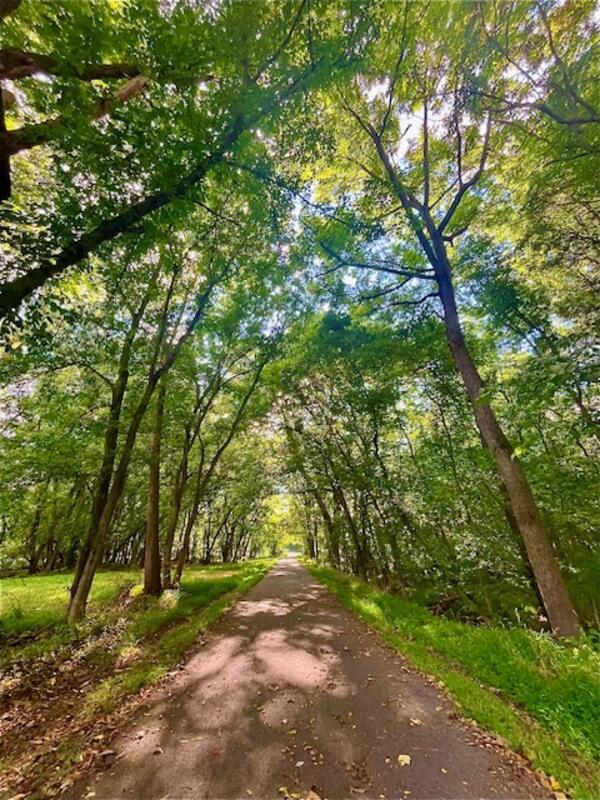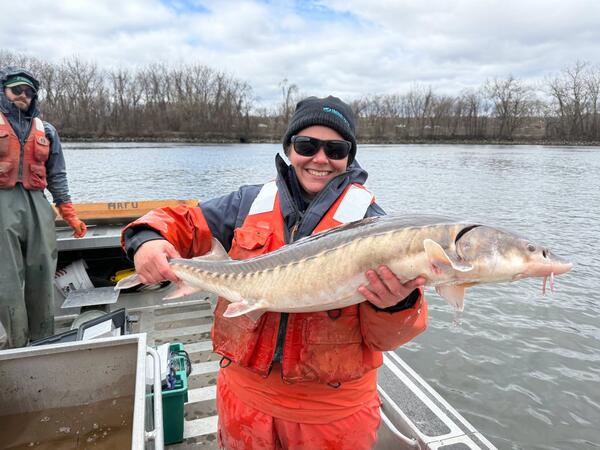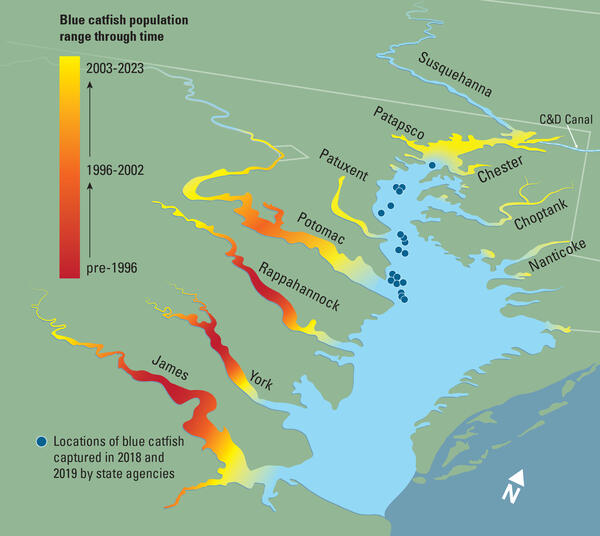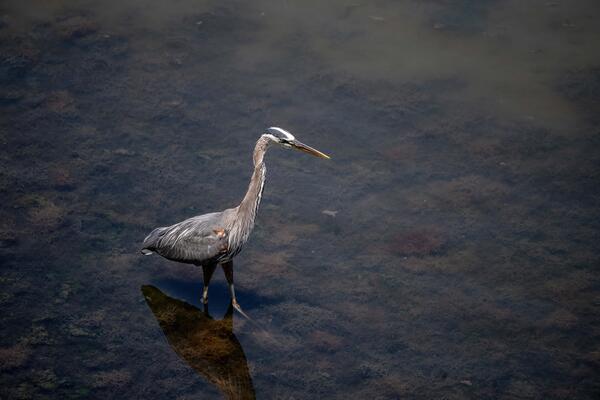A blue catfish (Ictalurus furcatus) swims in the shallows of Dogue Creek near Mount Vernon, Virginia.
Multimedia
Images
A blue catfish (Ictalurus furcatus) swims in the shallows of Dogue Creek near Mount Vernon, Virginia.
One of the many trails at Leetown Research Laboratory behind the Fish Health building. It is a beautiful, shaded path that leads to the baseball field and degassing building. A very relaxing place to stroll and listen to the birds in the woods on either side of the path. Oftentimes, flycatchers can be heard or spotted in this area.
One of the many trails at Leetown Research Laboratory behind the Fish Health building. It is a beautiful, shaded path that leads to the baseball field and degassing building. A very relaxing place to stroll and listen to the birds in the woods on either side of the path. Oftentimes, flycatchers can be heard or spotted in this area.
Sturgeons are among the most endangered animals globally. Once plentiful along the Atlantic coast, the shortnose sturgeon suffered severe population declines due to overfishing and habitat loss. In 1973, it was listed under the federal Endangered Species Act, as the Hudson River—its key habitat—was heavily polluted and oxygen-deprived.
Sturgeons are among the most endangered animals globally. Once plentiful along the Atlantic coast, the shortnose sturgeon suffered severe population declines due to overfishing and habitat loss. In 1973, it was listed under the federal Endangered Species Act, as the Hudson River—its key habitat—was heavily polluted and oxygen-deprived.
Native to the Mississippi, Ohio, Missouri, and Rio Grande Rivers, blue catfish were first introduced as a novel sportfish to the James River in the 1970s (Chesapeake Bay Program, 2020). The map below depicts observational records of the spatial and temporal invasion of blue catfish in the Chesapeake Bay.
Native to the Mississippi, Ohio, Missouri, and Rio Grande Rivers, blue catfish were first introduced as a novel sportfish to the James River in the 1970s (Chesapeake Bay Program, 2020). The map below depicts observational records of the spatial and temporal invasion of blue catfish in the Chesapeake Bay.
The great blue heron (Ardea herodias) is a large, wading bird known for its striking blue-gray plumage, long legs, and graceful demeanor, commonly found near water bodies across North America. This one was photographed in Ocean City, MD.
The great blue heron (Ardea herodias) is a large, wading bird known for its striking blue-gray plumage, long legs, and graceful demeanor, commonly found near water bodies across North America. This one was photographed in Ocean City, MD.
Tom O'Connell is the Center Director for the Eastern Ecological Science Center.
Tom O'Connell is the Center Director for the Eastern Ecological Science Center.
Videos
 Image of a group of technicians next to a river. Text: The USGS Northeast Region: Delivering Science for Better Decisions.
Image of a group of technicians next to a river. Text: The USGS Northeast Region: Delivering Science for Better Decisions.
The USGS Northeast Region: Delivering Science for Better Decisions
The USGS Northeast Region: Delivering Science for Better DecisionsThis video is an introduction of the USGS Northeast Region's science efforts to support society's evolving needs through its engaged and skilled workforce.
The USGS Northeast Region: Delivering Science for Better Decisions
The USGS Northeast Region: Delivering Science for Better DecisionsThis video is an introduction of the USGS Northeast Region's science efforts to support society's evolving needs through its engaged and skilled workforce.
 U.S. Geological Survey. Laboratory for the Analysis of Per-and Polyfluoroalkyl Substances (PFAS)
U.S. Geological Survey. Laboratory for the Analysis of Per-and Polyfluoroalkyl Substances (PFAS)
USGS Laboratory for the Analysis of Per- and Polyfluoroalkyl Substances (PFAS)
USGS Laboratory for the Analysis of Per- and Polyfluoroalkyl Substances (PFAS)The U.S. Geological Survey laboratory for the analysis of per- and polyfluoroalkyl substances (PFAS) uses cutting-edge techniques to analyze environmental samples including tissues, plasma, water, and soils to undertake and support research projects across the country.
USGS Laboratory for the Analysis of Per- and Polyfluoroalkyl Substances (PFAS)
USGS Laboratory for the Analysis of Per- and Polyfluoroalkyl Substances (PFAS)The U.S. Geological Survey laboratory for the analysis of per- and polyfluoroalkyl substances (PFAS) uses cutting-edge techniques to analyze environmental samples including tissues, plasma, water, and soils to undertake and support research projects across the country.
Bird Collisions: Current Science and Future Opportunities
Bird Collisions: Current Science and Future OpportunitiesThe USGS Eastern Ecological Science Center Bird Banding Lab webinar on the threat of bird collisions, current science and future opportunities. It is estimated that over 1 billion birds are killed annually by collisions with glass every year in the United States.
Bird Collisions: Current Science and Future Opportunities
Bird Collisions: Current Science and Future OpportunitiesThe USGS Eastern Ecological Science Center Bird Banding Lab webinar on the threat of bird collisions, current science and future opportunities. It is estimated that over 1 billion birds are killed annually by collisions with glass every year in the United States.
 Thumbnail text: USGS Eastern Ecological Science Center BSL-3 Laboratory
Thumbnail text: USGS Eastern Ecological Science Center BSL-3 Laboratory
USGS Eastern Ecological Science Center BSL-3 Laboratory
USGS Eastern Ecological Science Center BSL-3 LaboratoryThe BSL-3 complex at the USGS Eastern Ecological Science Center was purpose-built to serve our Nation’s needs. This facility has special engineering and design features for maintaining a safe environment when working with diseases that spread in the air. The facility is unusual in that it is designed to also be used for work with aquatic animals
USGS Eastern Ecological Science Center BSL-3 Laboratory
USGS Eastern Ecological Science Center BSL-3 LaboratoryThe BSL-3 complex at the USGS Eastern Ecological Science Center was purpose-built to serve our Nation’s needs. This facility has special engineering and design features for maintaining a safe environment when working with diseases that spread in the air. The facility is unusual in that it is designed to also be used for work with aquatic animals
2022 Blotchy Bass Syndrome Biosurveillance Project
2022 Blotchy Bass Syndrome Biosurveillance ProjectBlotchy bass syndrome (BBS) is the presence of hyperpigmentation (melanosis) on the external surface of black basses. This condition has received increased attention from anglers and resource managers in recent years and is a popular topic of discussion and reporting on angling websites and blogging platforms.
2022 Blotchy Bass Syndrome Biosurveillance Project
2022 Blotchy Bass Syndrome Biosurveillance ProjectBlotchy bass syndrome (BBS) is the presence of hyperpigmentation (melanosis) on the external surface of black basses. This condition has received increased attention from anglers and resource managers in recent years and is a popular topic of discussion and reporting on angling websites and blogging platforms.
 Text reads: Native Bee Inventory Monitoring Lab. Images of bee and flower.
Text reads: Native Bee Inventory Monitoring Lab. Images of bee and flower.
USGS Native Bee Inventory and Monitoring Lab at Eastern Ecological Science Center
USGS Native Bee Inventory and Monitoring Lab at Eastern Ecological Science CenterThe USGS Native Bee Inventory and Monitoring Lab designs and develops large and small scale surveys for native bees. As part of this work we also develop identification tools and keys for native bee species. One aspect of creating those tools is creating accurate and detailed pictures of native bees and the plants and insects they interact with.
USGS Native Bee Inventory and Monitoring Lab at Eastern Ecological Science Center
USGS Native Bee Inventory and Monitoring Lab at Eastern Ecological Science CenterThe USGS Native Bee Inventory and Monitoring Lab designs and develops large and small scale surveys for native bees. As part of this work we also develop identification tools and keys for native bee species. One aspect of creating those tools is creating accurate and detailed pictures of native bees and the plants and insects they interact with.









